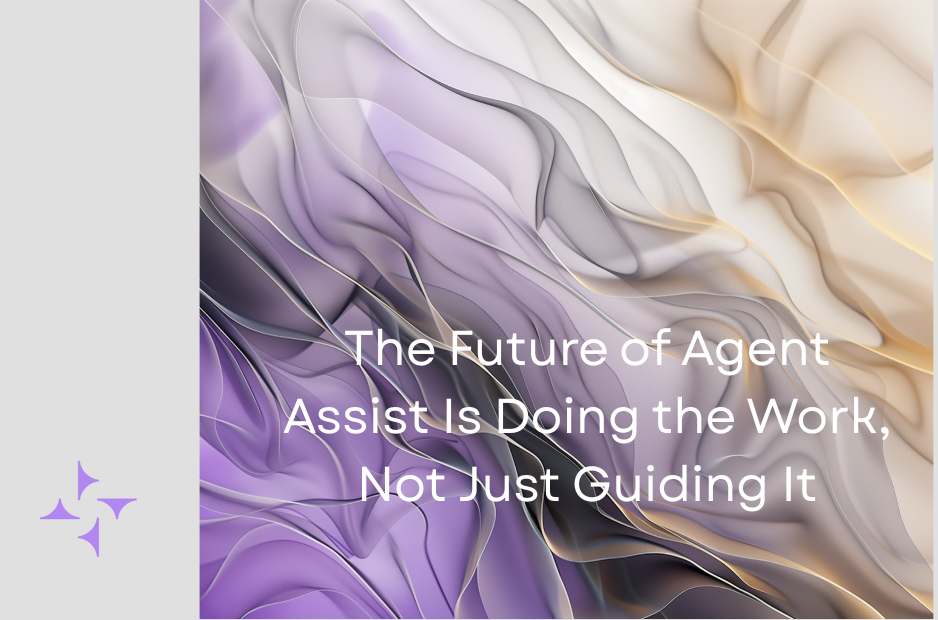At Spring Labs, we practice customer-in-the-loop product development — continuously refining our roadmap based on real-world feedback: the daily pain points, the gaps customers wish were filled, and the features they’ve seen elsewhere that seem promising.
Sometimes those suggestions translate directly into new features. But often, we take a step back and ask: what’s the underlying friction we’re solving for? And is there a more effective, scalable way to address it?
One recurring theme we hear is the challenge of frontline agent efficiency. A common approach in the market today is real-time agent assistance: generative AI copilots that surface relevant data, suggest next steps, and guide agents through disclosures and workflows. It’s an intuitive concept and on paper, it feels like the future.
But in practice, it often leads to cognitive overload.
The intent is sound and the pain is real, but the assumption is flawed: that efficiency comes from helping agents think faster and do more in less time. In reality, it comes from doing less, better, through automation, intelligent workflows, and system design that removes friction instead of adding to it.
🧠 The Limits of Human Processing
According to Cognitive Load Theory (Sweller, 1988), working memory is severely limited — most adults can hold only 3 to 5 chunks of information at once. CX agents who handle routine and non-strategic servicing — like transaction fraud, account updates, or credit dispute initiations — tend to operate sequentially:
This step-by-step reasoning is linear and structured — and it doesn’t mesh well with real-time information floods. Even if we provide the agent with all relevant data and policies upfront, it doesn’t necessarily save time. Instead, it shifts the burden to the agent to parse, prioritize, and act, which can actually increase resolution times and compliance risks.
Even one of the frequently cited studies (Noy & Zhang, 2023) on AI copilots in customer support — covering over 5,000 agents — found no meaningful performance improvement for experienced, high-skilled agents, and in some cases, even noted slight declines in quality. The gains were largely confined to novice agents, and even then, were limited to rare or infrequent scenarios where those agents lacked prior knowledge. On routine and common issues, productivity gains disappeared — with novices performing at levels comparable to experienced agents.
As Herbert Simon's theory of bounded rationality suggests, humans make decisions within cognitive limits. In high-pressure environments like call centers, agents can't be expected to optimize across a deluge of inputs in real time.
⚙️ Automation Beats Real-Time Advice
Real gains come not from surfacing better suggestions but from removing the need for decision-making altogether. When the task is repeatable and rules-based, automating the action is faster and more accurate than nudging the agent.
A 2025 McKinsey report highlights that AI automation in contact centers, such as deploying AI agents for transactional queries, has achieved a 50% reduction in cost per call and reduced authentication times by up to 60 seconds, outperforming guidance tools that primarily enhance agent productivity without directly handling tasks.
This aligns with decades of human factors research, which shows that reducing task complexity improves both speed and consistency (Parasuraman & Riley, 1997). When agents are freed from repetitive cognitive tasks, they don’t just work faster — they make fewer mistakes.
🎯 Where Real-Time Agent Assist Is Valuable
There are domains where agents aren't just following a process — they’re making strategic, adaptive decisions in the moment. This is where real-time assist tools can provide immense value.
1. Risk and Compliance Signaling
Real-time alerts in these scenarios help agents pause, escalate, or course-correct before a compliance issue arises — turning risk mitigation into a proactive function.
2. Revenue Protection and Strategic Selling
In these moments, the agent is in control — but real-time guidance acts as a true copilot, not a taskmaster.
🧠 First Principles of CX Efficiency
True efficiency doesn’t come from speeding up clicks or coaching decision trees. It comes from reimagining workflows from first principles:
This is the future of frontline support agent efficiency: repeatable tasks are fully automated through self-service voice and chat AI agents, removing the need for manual intervention. Real-time assistance is reserved for strategic moments — when human judgment, adaptability, or emotional intelligence truly add value.



